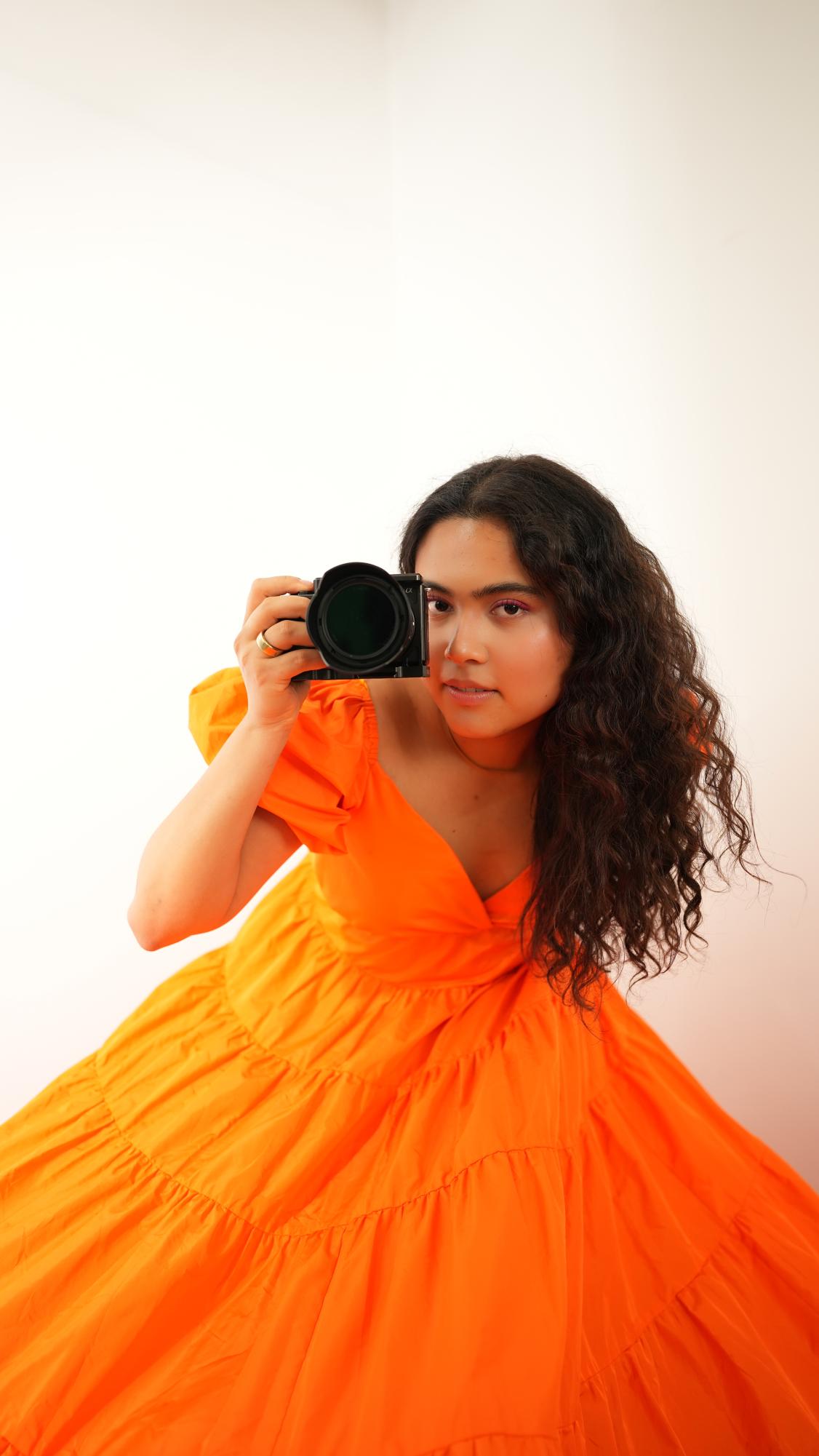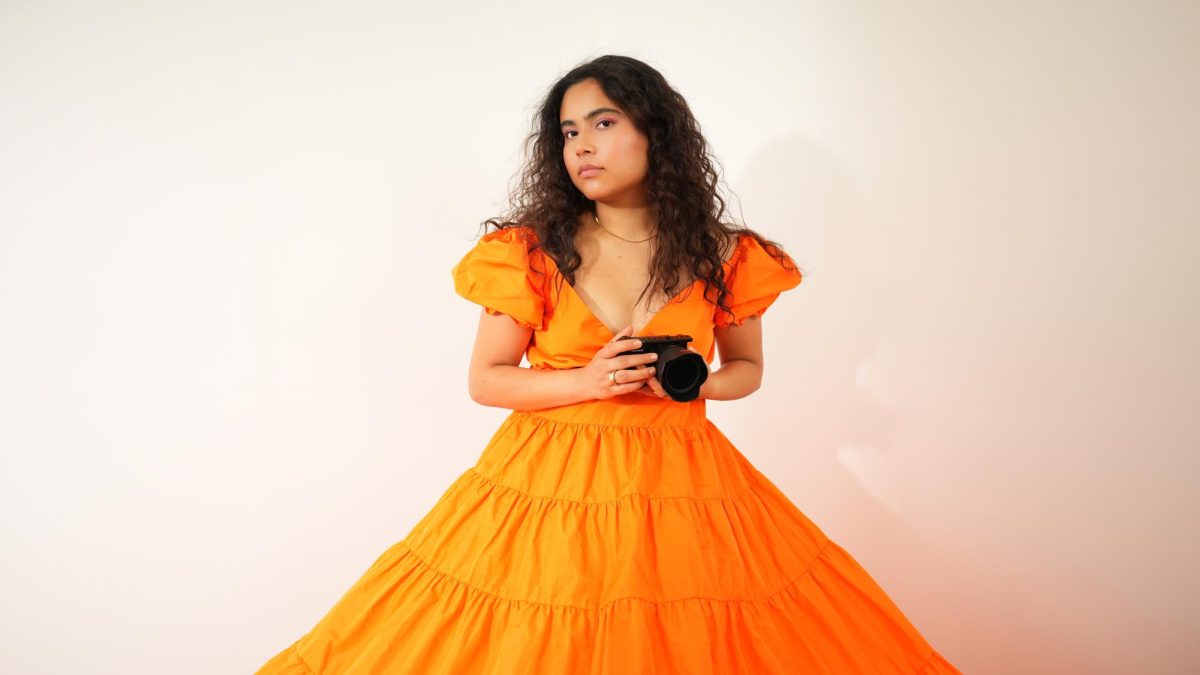Paulina Delabra Serrano, a student at Fordham College at Lincoln Center ’26 majoring in math and computer science, has acquired some form of campus notoriety among the student body for her price-free headshots and overall knack for photography. After spending years fostering a deep interest in the art, Delabra Serrano began developing a multiplicity of styles in her work upon arriving in New York City.
A New York City Adventure
New York City is big, and it is comparatively bigger when you are a first-year in college from San Juan Del Rio, Queretaro — or at least that’s been Delabra Serrano’s experience. Growing up in Mexico, she was less exposed to the chaos in the mundane so readily accessible in New York City. Palpable in her images is the sense that her photography has grown with her. Before embarking on a street photography journey, Delabra Serrano began shooting with still subjects and later began to take portraits, ultimately shooting with other Fordham students, cultivating the vibrance and creative allure of the Lincoln Center campus.
The word she uses to describe the changes in her photography: “evolution.” She has evolved from a strict color gradient and a focus on geometry to a more comprehensive approach to colors, seeking to capture the essence of her subjects in each picture.
Initially, she also explored videography, but Delabra Serrano’s focus gradually shifted solely to photography upon relocating to the city. She discovered that photography, driven only by the desire to convey the universal language of emotions, was the truer form of her passion for capturing moments. Delabra Serrano’s photography reflects her development and understanding of the world around her.
Still, she waited a year to begin sharing her images. First, on Pinterest, and next her very own website. From there she began meeting people with whom she could collaborate, from aspiring models to makeup artists and soon enough, Fordham students began reaching out to her for portraits. All very organic.
The problem as lying not in our perception of our environment, but in the craft of seizing a fleeting moment.
A Girl and Her Camera
Delabra Serrano has always had an interest in cameras themselves. When asked further about what inspired this fixation, she admitted that “it is the buttons.” The camera buttons are appealing to Delabra Serrano for their ability to transform and create.
The transformative nature of cameras and their nuanced function have been deeply intriguing for Delabra Serrano ever since she picked up this hobby when she was nine or 10. She described each of the cameras she has owned nostalgically: those gifted, self-bought and lost, listing them in chronological order.
For Delabra Serrano, and in true mathematics major fashion, photography is akin to problem solving. She noted the problem as lying not in our perception of our environment, but in the craft of seizing a fleeting moment. To encapsulate an emotive moment and translate that successfully in a picture is what Delabra Serrano finds exhilarating about photography.
“To me, photography, like numbers, it’s universal,” Delabra Serrano said. “Sure there’s context important in a picture, but photography can be pretty universal. You can feel sad in any language.”
From her first pictures, taken on a disposable “Bratz” themed camera, to her newer portraits, taken on her Sony, Delabra Serrano has been capturing stills of her surroundings since she was young. Her interest in photography predates her access to an environment as rich in expression as New York City.
Delabra Serrano began taking photography classes in her native San Juan del Rio, Queretaro. In photographing still life in her instructor’s home at around age 14, she gauged that the setting in which a picture is taken is equally as important as the subject. There’s ingenuity in crafting the mise en scène — the ambience and arrangement — of an apple. Starting as a novice opportunist, Delabra Serrano took advantage of familial events to take pictures and then photographed her surroundings for personal use: primarily for her Instagram grid.
“I was yet to recognize photography as an art form,” she recounted.
“To me, photography, like numbers, it’s universal.”Paulina Delabra Serrano, FCLC ’26
According to Delabra Serrano, her first photographs were more utilitarian in nature, as she had not yet recognized photography as something that she wanted to pursue purley for her enjoyment of the craft, unmarried from an ultimate goal of publication to social media. Upon her choice to delete Instagram, she began discovering self-portraits and their potential for expression through their geometry, light and surroundings, beyond the desire to perform through social media.
From her original instruction at the age of 14, Delabra Serrano still holds what she defined as “the holy trinity of photography” near and dear: “aperture, ISO and shutter speed.” More poetically, she tells me that the Greek origin of the word “photography” informs her technique: Photo and grafos are “Greek for writing with light.”
It is clear that Delabra Serrano carries with her a load of technical knowledge regarding lenses and cameras. She is a bonafide history buff — at least when it comes to the camera company Leica and its cult-like following — but she emphasizes that she remains on the periphery of this devoted community. Her skill, however, has been mostly garnered through experience; “Everyone will tell you this, but I think it’s worth repeating: Go out there and shoot!”

Delabra Serrano’s artistic growth in photography has been shaped dialectically with the cameras she uses. Remembering the person who guided her first New-York camera purchase, it is evident that she meticulously weighs the camera’s capabilities and her aspirations before making decisions that almost take her to “financial ruin.”
Delabra Serrano’s exploratory approach to photography is also represented in the nature of her pictures. Unlike the condition of most 20-somethings, Delabra Serrano feels no urge to define her photography as only one thing. Instead, she focuses on the experimental aspect inherent in creativity. Her photos have changed with the cameras she has used and what has surrounded her. Simply put, her photography authentically follows her growth as a person. She acknowledges that to define her photographic style is something that “takes time,” which is scarce as a full-time student and young person still finding their way in the world.
In her street photography, Delabra Serrano aims to capture the distinct human essence in emotional moments. She cites her series depicting people holding hands, while walking down the street, emphasizing that finding unsuspecting subjects is imperative to convey genuine, nuanced expression. Her profound appreciation for the intricacies within each individual is evident in the multitude of descriptors she uses before ultimately landing on the elusive: “je ne sais quoi” that imbues each person holding hands with a unique narrative.
“It’s an exercise of empathy.”Paulina Delabra Serrano, FCLC ’26
There is an unexplored language in the body that, although most cannot easily translate into meaning, Delabra Serrano seeks to explore and communicate in her pictures. For her, photography goes beyond mere capture; it’s a necessity, a means to actively engage with others in a manner that reflects her authentic self.
Recently, Delabra Serrano has slowed down in the publication of street photography and has shifted gears toward portraits. This was more so unplanned, but an exciting pivot, as she continues to grow in her medium and has been able to connect with an increasing number of people both in the fashion industry, or soon-to-be moguls in the Fordham community. In her transition to portrait photography, she strives to maintain her authenticity.
Delabra Serrano’s interest lies in her belief that every picture inevitably carries an essence of the portrayed individual, bearing the natural awkwardness often seen in family portraits taken at a local JCPenny, for example. When photographing portraits, she acknowledges the photographer’s responsibility to reveal the beauty within each of her subjects. The relationship between a photographer and the model is to learn from each other, to cohesively work together to create a picture that fulfills both peoples artistic vision.
“It’s an exercise of empathy,” she said.
Looking Ahead
As for the future, Delabra Serrano stressed her status as a student, staunchly asserting herself as an “adult in-progress.” She, however, noted that she does not plan on stopping taking pictures. Although she does not yet describe herself as a capital-A-artist, Delabra Serrano considers her craft a lifelong project.
Delabra Serrano is less concerned with establishing herself in “the scene” and more so with the experimental possibilities of photography. “I am going to be a photographer my whole life,” she said.
In her photography, it is quite evident how important Delabra Serrano finds the relationship between herself and her subject. Not only in her portrait work, which she continues to exercise as a process of empathy, but also in her street photography. In this sense, Delabra Serrano conveys that photography is a game of close observation.
The sophomore’s photographic odyssey unfolds as a testament to the transformative power of the art form, reflecting not only her technical prowess, but also her profound personal and artistic growth. Through her lens, she navigates the intricate landscapes of human emotion and connection, crafting a narrative that transcends mere imagery to encapsulate the essence of her subjects.

